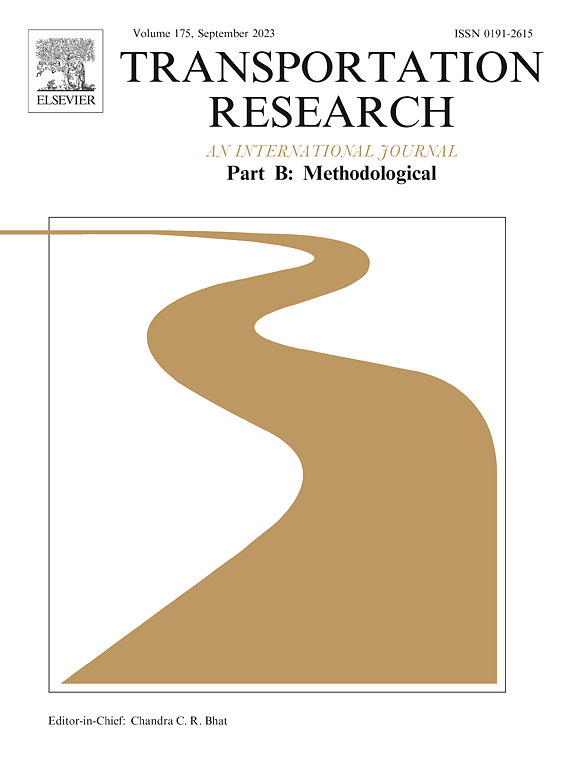A modified late arrival penalized user equilibrium model and robustness in data perturbation
IF 6.3
1区 工程技术
Q1 ECONOMICS
引用次数: 0
Abstract
In a seminal paper (Watling, 2006), Watling proposes a stochastic variational inequality approach to model traffic flow equilibrium over a network where the transportation time is random and a path is selected by to transport if the user’s expected utility of the transportation of the path is maximized over their paths. A key feature of Watling’s model is that the user’s utility function incorporates a penalty term for lateness and the resulting equilibrium is known as Late Arrival Penalized User Equilibrium (LAPUE). In this paper, we revisit the LAPUE model with a different focus: we begin by adopting a new penalty function which gives a smooth transition of the boundary between lateness and no lateness and demonstrate the LAPUE model based on the new penalty function has a unique equilibrium and is stable with respect to (w.r.t.) small perturbation of probability distribution under moderate conditions. We then move on to discuss statistical robustness of the modified LAPUE (MLAPUE) model by considering the case that the data to be used for fitting the density function may be perturbed in practice or there is a discrepancy between the probability distribution of the underlying uncertainty constructed with empirical data and the true probability distribution in future, we investigate how the data perturbation may affect the equilibrium. We undertake the analysis from two perspectives: (a) a few data are perturbed by outliers and (b) all data are potentially perturbed. In case (a), we use the well-known influence function to quantify the sensitivity of the equilibrium by the outliers and in case (b) we examine the difference between empirical distributions of the equilibrium based on perturbed data and the equilibrium based on unperturbed data. Moreover, we extend the discussions in case (b) to the LAPUE model and the other UE models. To examine the performance of the MLAPUE model and our theoretical analysis of statistical robustness, we carry out some numerical experiments, the preliminary results confirm the statistical robustness as desired.
一个改进的迟到惩罚用户均衡模型和数据扰动的鲁棒性
在一篇开创性的论文(Watling, 2006)中,Watling提出了一种随机变分不等式方法来模拟网络上的交通流平衡,其中运输时间是随机的,如果用户对路径运输的期望效用在其路径上最大化,则选择一条路径进行运输。Watling模型的一个关键特征是用户的效用函数包含了迟到的惩罚项,由此产生的均衡被称为迟到惩罚用户均衡(LAPUE)。本文从不同的角度重新审视了LAPUE模型:我们首先采用了一个新的惩罚函数,它给出了延迟和不延迟之间边界的平滑过渡,并证明了基于新惩罚函数的LAPUE模型在中等条件下对概率分布的(w.r.t)小扰动具有唯一的平衡和稳定。然后,考虑到用于拟合密度函数的数据在实际中可能受到扰动,或者由经验数据构建的潜在不确定性的概率分布与真实概率分布之间存在差异,我们将继续讨论改进的LAPUE (MLAPUE)模型的统计鲁棒性,我们将研究数据扰动如何影响平衡。我们从两个角度进行分析:(a)少数数据受到异常值的扰动;(b)所有数据都可能受到扰动。在情况(a)中,我们使用众所周知的影响函数通过异常值来量化平衡的敏感性,在情况(b)中,我们检查基于扰动数据的平衡的经验分布与基于未扰动数据的平衡之间的差异。此外,我们将案例(b)中的讨论扩展到LAPUE模型和其他UE模型。为了检验MLAPUE模型的性能和我们对统计稳健性的理论分析,我们进行了一些数值实验,初步结果证实了统计稳健性。
本文章由计算机程序翻译,如有差异,请以英文原文为准。
求助全文
约1分钟内获得全文
求助全文
来源期刊
CiteScore
12.40
自引率
8.80%
发文量
143
审稿时长
14.1 weeks
期刊介绍:
Transportation Research: Part B publishes papers on all methodological aspects of the subject, particularly those that require mathematical analysis. The general theme of the journal is the development and solution of problems that are adequately motivated to deal with important aspects of the design and/or analysis of transportation systems. Areas covered include: traffic flow; design and analysis of transportation networks; control and scheduling; optimization; queuing theory; logistics; supply chains; development and application of statistical, econometric and mathematical models to address transportation problems; cost models; pricing and/or investment; traveler or shipper behavior; cost-benefit methodologies.

 求助内容:
求助内容: 应助结果提醒方式:
应助结果提醒方式:


